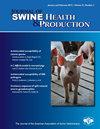Retrospective study of lameness cases in growing pigs associated with joint and leg submissions to a veterinary diagnostic laboratory
IF 0.7
4区 农林科学
Q3 Agricultural and Biological Sciences
引用次数: 5
Abstract
Objective: The objective of this study was to categorize and quantify the most common causes of joint- or leg-associated lameness by summarizing available information from cases presented to the Iowa State University Veterinary Diagnostic Laboratory (ISU VDL) between 2010 and 2015. Materials and methods: All cases of lameness or locomotor dysfunction in 7- to 40-week-old pigs submitted to the ISU VDL between May 1, 2010 and April 30, 2015 were retrieved. After removing cases that did not meet the inclusion criteria, the remaining cases were individually reviewed and assigned a primary and secondary diagnosis. Results: Of the 1847 cases retrieved, 464 met the inclusion criteria. The 4 most common primary diagnosis categories were Mycoplasma hyosynoviae (93 cases; 20%), metabolic bone disease (86 cases; 18.5%), infectious arthritis due to non-Mycoplasma bacterial infection (81 cases; 17.5%), and lameness with inconclusive findings (101 cases; 21.8%). There were 23.3% of the cases (108 of 464 cases) that had a secondary diagnosis with metabolic bone disease (28.7%; 31 of 108 cases) identified as the most common secondary diagnosis. Implications: This study reinforces the importance of careful clinical examination, proper sampling, and confirming causes with appropriate diagnostic testing for accurate diagnosis of lameness.向兽医诊断实验室提交与关节和腿部相关的生长猪跛行病例的回顾性研究
目的:本研究的目的是通过总结2010年至2015年间提交给爱荷华州立大学兽医诊断实验室(ISU VDL)的病例的可用信息,对关节或腿部相关跛行最常见的原因进行分类和量化。材料和方法:检索2010年5月1日至2015年4月30日提交给ISU VDL的7 ~ 40周龄的跛行或运动功能障碍猪的所有病例。在剔除不符合纳入标准的病例后,对剩余病例进行单独审查,并进行初级和次级诊断。结果:1847例病例中,464例符合纳入标准。最常见的4种主要诊断类型为:舌滑膜支原体(93例);20%),代谢性骨病(86例;18.5%),非支原体细菌感染所致感染性关节炎(81例;17.5%),跛行表现不明确(101例;21.8%)。464例患者中有108例(23.3%)继发诊断为代谢性骨病(28.7%;108例中有31例)被确定为最常见的继发诊断。意义:本研究强调了仔细的临床检查,适当的采样,并通过适当的诊断测试确认原因的重要性,以准确诊断跛行。
本文章由计算机程序翻译,如有差异,请以英文原文为准。
求助全文
约1分钟内获得全文
求助全文
来源期刊
CiteScore
1.80
自引率
0.00%
发文量
29
审稿时长
>36 weeks
期刊介绍:
The Journal of Swine Health & Production (JSHAP) is an open-access and peer-reviewed journal published by the American Association of Swine Veterinarians (AASV) since 1993. The aim of the journal is the timely publication of peer-reviewed papers with a scope that encompasses the many domains of applied swine health and production, including the diagnosis, treatment, management, prevention and eradication of swine diseases, welfare & behavior, nutrition, public health, epidemiology, food safety, biosecurity, pharmaceuticals, antimicrobial use and resistance, reproduction, growth, systems flow, economics, and facility design. The journal provides a platform for researchers, veterinary practitioners, academics, and students to share their work with an international audience. The journal publishes information that contains an applied and practical focus and presents scientific information that is accessible to the busy veterinary practitioner as well as to the research and academic community. Hence, manuscripts with an applied focus are considered for publication, and the journal publishes original research, brief communications, case reports/series, literature reviews, commentaries, diagnostic notes, production tools, and practice tips. All manuscripts submitted to the Journal of Swine Health & Production are peer-reviewed.

 求助内容:
求助内容: 应助结果提醒方式:
应助结果提醒方式:


